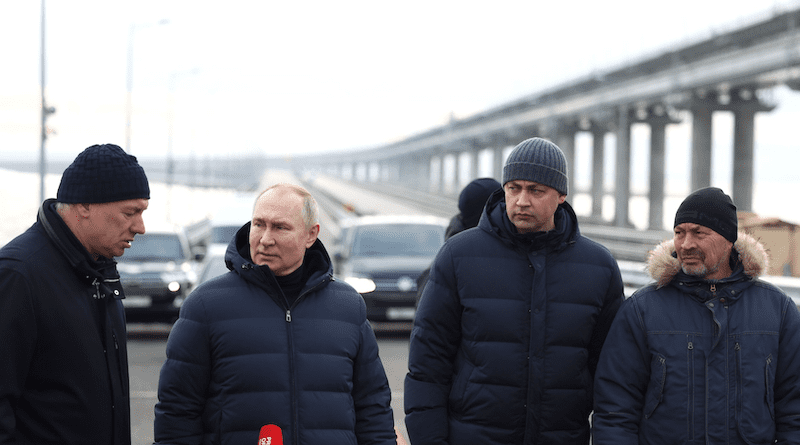The Current Scenario Of War In Ukraine Following The Targeting Of The Kerch Bridge – OpEd
The Ukraine war is taking new security dimensions every day. The explosion on October 8 tore down a part of the Kerch bridge which connects Russia to the Crimean Peninsula. This attack hit a Russian military supply route and a symbol of its power. The separation of four regions from Ukraine and the recent Ukrainian attack on the Kerch bridge have brought the war to a decisive moment. Meanwhile, with the advent of winter, the energy crisis will be added to the Ukraine war for the Europeans which is exactly what Putin has been waiting for. In this time of crisis, the question is whether Russia is willing to back down from its positions, considering the developments on the battlefield and the pressures of the West.
Perception of threat is what drives a country to fight, in the sense that threats can exist but can be actualized depending on an actor’s response. Many of the wars that the world has seen can be traced to how a threat was processed by an actor and the reaction of other actors around the world. Humiliation and pressure on Germany in the Versailles peace, the passivity of people like Chamberlain, Stalin’s collusion in the face of the Nazi threat, and NATO’s efforts to advance to the borders of Russia are examples of how West and in the recent case of America have triggered a war.
In the American security puzzle after the Cold War, Russia was still a potential enemy that had to be contained through a territorial blockade, the expansion of multifaceted military alliances, and keeping it weak. In this puzzle, in addition to maintaining and intensifying Russia’s threat to Europe and the free world, practically all possible means should be used to curb its military power. But the problem got worse when not only the threat of Russia was not solved, but also the threat of China was added to it. The bond among the actors against the American world order and against the domination of the West has now brought about modern security blocks in East and West or in other words the opponents and supporters of the American world order.
Centuries ago, Clausewitz called the war a continuation of diplomacy in another way. When Russia repeatedly demanded its neighboring countries not to join NATO, maybe no one thought that one day due to the West’s stubbornness on NATO’s expansion strategy, Ukraine and Europe would become victims of the American security order. Before the start of the war in Ukraine, Putin repeatedly demanded all NATO parties, especially the Americans, to abandon the strategy of encirclement of Russia. This is while even after the massive deployment of troops on the border with Ukraine, he tried to dissuade Ukraine from joining NATO this time with direct military pressure, which was met with Kyiv’s rejection. Ukraine’s joining NATO would practically put Moscow within 400 kilometers of NATO missiles’ range, which naturally, perhaps no rational actor would accept this direct existential threat against its territorial integrity.
The fact that conditional defense, preemptive attack, understanding of a threat, and the nature of a threat all have American definitions make things more complicated. The United States which was ready for a nuclear war in 1961 during the presidency of Kennedy to prevent Soviet missiles from being deployed on Cuban soil in his neighborhood, now does not accept the corresponding threat for another actor.In the new American order, the issue is not about security and insecurity in general, the issue here is who is this security or insecurity for? In this definition of security, the maritime and territorial blockade of China and Russia is considered to be security-building, and security is not a general concept for everyone, which should provide the interests of the new American order. In this understanding of the threat of Russia, along with China, their military should be neutralized. In this sense, in addition to the complete military blockade and economic pressure, other powers must commit to obeying the laws of the American world order.
Since the beginning of the war, after ignoring Russia’s security demands, the West has tried two ways to stop the war: 1) extensive economic sanctions and 2) increasing Russia’s military-security spending. The goal of these two ways which are pursued simultaneously is to change Russia’s cost-benefit calculations in the Ukraine war. In political security and strategic theories, a rational actor is considered to be a party that considers cost-benefit calculations. However, the problem arises when a war is started by a great power. In this situation, the question of credibility takes the place of cost-benefit calculations.
It doesn’t seem that current Russia under the leadership of Putin wants to change its calculations with the policy of increasing economic-military pressure on the West. Here, the issues are increasing the speed of actions and escalation to dominate the other side. This means that Russia, as a credible actor, is not only not ready to back down from its demands and the areas it has settled on its territory, but the possibility of resorting to nuclear weapons is not unlikely in case of more pressure on Moscow. This is while now there is no guarantee that the war will not be dragged into the heart of Europe, which faces both security and energy threats from Russia. It is highly unlikely that things return back to normal as Europe has once again become the victim of maintaining the American strategy of order through war. In the end, whatever happens, will eventually bring with it the seeds of change in the New World Order, a path from which no one can imagine returning.

